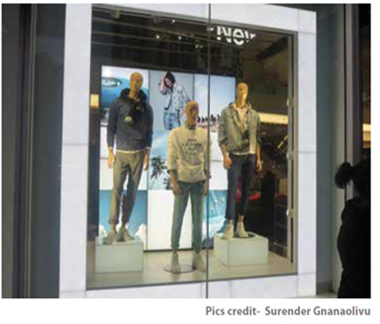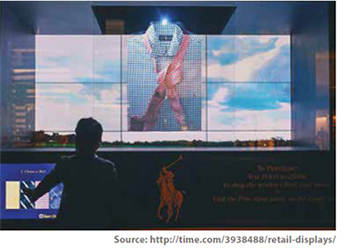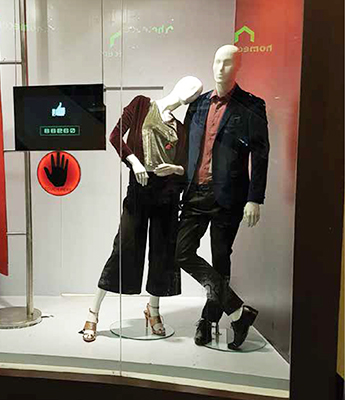The ‘Art & Tech’ of Window Displays
By Surender Gnanaolivu | October 03, 2017
Despite the growth of pure play online giants, brick-and-mortar retailers still control over 95% of the market globally. However, the retail streetscape has seen some disruptive ways of blending the omnichannel expectations of customer at the storefront using new innovative technological development in window displays to deliver undated and memorable storefront experiences.
 With the popularization of video content across all channel, the triggers for ‘attracting’ and creating ‘interest’ for shoppers at physical store windows have moved from impactful installations to dynamic video content in Digital Window Displays of today. Thanks to the compulsive habits of the usage of smartphones by new-age consumers, interactivity will soon become a necessity at physical store touch points. Trends have shown that the ‘Art and Science’ of display has now been transformed to the ‘Art and Tech’ of display.
With the popularization of video content across all channel, the triggers for ‘attracting’ and creating ‘interest’ for shoppers at physical store windows have moved from impactful installations to dynamic video content in Digital Window Displays of today. Thanks to the compulsive habits of the usage of smartphones by new-age consumers, interactivity will soon become a necessity at physical store touch points. Trends have shown that the ‘Art and Science’ of display has now been transformed to the ‘Art and Tech’ of display.
Looking at the developments in technology and its application in this front by many leading brands globally, Digital Window Displays can be classified into 4 window display techniques- Digital Prop, Digital Wall, Digital Interactive and Digital Hybrid windows. Below are some examples of innovative applications that illustrate the new ‘Art and Tech’ of Window Display.
Digital Prop Windows: Impactful Window displays are traditionally stories that are told through a combination of stylized product displays on mannequins, complementing props, graphics and messaging. Window dressers of today use digital devices as props in windows that add value by dynamic imaging and messages in window display stories to create impactful presentations at the store front. Check out the window display at the new store concept at GAP at Oxford Street in London. The window uses a combination of screens as ‘digital prop’ that play brand videos for brand imagery on the backdrop and stylized mannequins on a turntable to compete the Digital Window Display. The screen splits into multiple images, screens and then comes together as a video wall creating great attention grabbing impact.
This is a very commonly used style with the digital screen occupying from a partial portion to the complete width and height of the window.
 Digital Interactive Windows: To take window displays to the next level, software and hardware developers have collaborated to create interactive surfaces that help customers to engage at store fronts with potential customers 24x7. A classic example is the window at Bloomingdale’s Manhattan flagship store where the interactive window was designed to convert passersby into buyers with six interactive windows that featured Ralph Lauren fashion. The dramatic window stopped shoppers in their tracks and enticed them to tap color swatches on touchscreens in the windows glass facing the sidewalk. The selected colored merchandise would get featured on the digital window behind the glass and if they liked what they saw, they could just text “POLO” for a link to a checkout page. The brand’s mission with his display was to ‘attract and create interest’ followed by ‘creating desire and conviction’ to act and opt to have their purchase hand-delivered on the sidewalk without setting foot into the store!
Digital Interactive Windows: To take window displays to the next level, software and hardware developers have collaborated to create interactive surfaces that help customers to engage at store fronts with potential customers 24x7. A classic example is the window at Bloomingdale’s Manhattan flagship store where the interactive window was designed to convert passersby into buyers with six interactive windows that featured Ralph Lauren fashion. The dramatic window stopped shoppers in their tracks and enticed them to tap color swatches on touchscreens in the windows glass facing the sidewalk. The selected colored merchandise would get featured on the digital window behind the glass and if they liked what they saw, they could just text “POLO” for a link to a checkout page. The brand’s mission with his display was to ‘attract and create interest’ followed by ‘creating desire and conviction’ to act and opt to have their purchase hand-delivered on the sidewalk without setting foot into the store!
Digital Wall Windows: This style of windows use strategically sized and placed screens to create stunning impact through digital content. The screens are integrated into the store architecture converting a conventional brick-and-mortar form into a stunning entertainment screen.
This digital award winning ‘live window’ installation by Benetton uses giant high resolution video-walls installed in all the windows of 10 flagship stores across their most important cities in the world. The cutting-edge software used for creating the imagery connects with all the ten stores around the world in real time. These stunning Digital Wall windows, void of their signature mannequin clusters, are transformed into constantly changing digital place-based media.
 Digital Hybrid Window: Brands and retailers have used hybrid models to achieve brand objectives from windows that use a combination of interactive technology in combination with conventional window displays. Lifestyle International from the Landmark Group uses technology to do social proofing of the fashion styling featured in their windows in India. Customers can place their hands on the window glass to add a ‘like’ to the digital counter in the window endorsing the fashion statement in the window display. The 66K likes do indicate the popularity of this social proofing technique in its windows.
Digital Hybrid Window: Brands and retailers have used hybrid models to achieve brand objectives from windows that use a combination of interactive technology in combination with conventional window displays. Lifestyle International from the Landmark Group uses technology to do social proofing of the fashion styling featured in their windows in India. Customers can place their hands on the window glass to add a ‘like’ to the digital counter in the window endorsing the fashion statement in the window display. The 66K likes do indicate the popularity of this social proofing technique in its windows.
Research and study done by content experts reveal that when customers are exposed to a combination of text, imagery, display and videos they retain 10% of the text, 65% of images & displays and 90% of videos. Digital Display windows use this very critical information to create memorable stories using the right mix of technology, content and media to maximize impact for the store and the brand.
In conclusion, it is very evident that these techniques are the way forward for windows displays at market places today to optimize the use of the most expensive asset in retail, the store space, to create memorable messages for customers and generate valuable ROI for the retailer through customer acquisition and sales

_165_265.jpg)
_165_265.jpg)





Comments